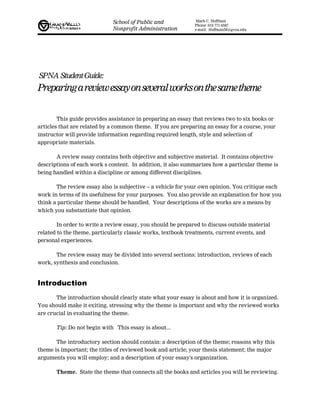
Review essay...
- 1. School of Public and Mark C. Hoffman Phone: 616 771-6587 Nonprofit Administration e-mail: HoffmanM@gvsu.edu SPNA Student Guide: Preparing a review essay on several works on the same theme This guide provides assistance in preparing an essay that reviews two to six books or articles that are related by a common theme. If you are preparing an essay for a course, your instructor will provide information regarding required length, style and selection of appropriate materials. A review essay contains both objective and subjective material. It contains objective descriptions of each work’s content. In addition, it also summarizes how a particular theme is being handled within a discipline or among different disciplines. The review essay also is subjective -- a vehicle for your own opinion. You critique each work in terms of its usefulness for your purposes. You also provide an explanation for how you think a particular theme should be handled. Your descriptions of the works are a means by which you substantiate that opinion. In order to write a review essay, you should be prepared to discuss outside material related to the theme, particularly classic works, textbook treatments, current events, and personal experiences. The review essay may be divided into several sections: introduction, reviews of each work, synthesis and conclusion. Introduction The introduction should clearly state what your essay is about and how it is organized. You should make it exiting, stressing why the theme is important and why the reviewed works are crucial in evaluating the theme. Tip: Do not begin with “This essay is about...” The introductory section should contain: a description of the theme; reasons why this theme is important; the titles of reviewed book and article; your thesis statement; the major arguments you will employ; and a description of your essay's organization. Theme. State the theme that connects all the books and articles you will be reviewing.
- 2. Importance of theme. You must make the case that this theme is worth exploring from the perspective of public administration. Among the various ways to do this, you should choose strongest. Some options are: Ÿ Note recent newsworthy events? Ÿ Cite recent articles in PA academic or professional publications? Ÿ Quote respected authorities who consider it important? Ÿ Describe real-life cases which illustrate the importance of the theme? Works reviewed. You may want to provide a list before your first paragraph. Even if you do this, you should still introduce each works with a one or two sentence description. Thesis statement. Your thesis statement concisely states your objective in writing the essay. You are not writing a mystery novel. Do not try to surprise your reader by keeping your thesis a secret until the end. Arguments. List arguments you will make to support your thesis. Each of these arguments will be restated and expanded in the body of your essay. Organization. Before launching into the body of your essay, explain what is going to follow. Review In the first part of your essay’s body, you write a summary of each of the works. Concentrate on the parts that directly relate to your theme. Ignore parts which are unrelated. Each work may be dealt with in as a separate section in the body of your essay. Alternatively, you might divide your essay into topical sections (e.g.: authors, perspectives, strengths, weaknesses) and write about one aspect of each work in each section. Tip: Use quotations to support your points. However, less than 20 percent of your text should be direct quotations. All quotations from the books and articles being reviewed should include only page references. Material from other sources should include a full reference. The author and the author’s intent. Write a one paragraph biographical sketch that highlights the author’s qualifications and background. Focus only on details that are relevant to the work, which may include academic and professional positions, personal achievements, and previous articles and books. With special attention to any prefatory or introductory material, describe the author’s admitted or implied intentions in writing the work. Consider where and when the author wrote the work, noting important influences. Content. State the thesis of the work (relevant to your theme) and summarize the work’s support of this thesis. Focus on ways this work sheds light on your theme.
- 3. Strengths and weaknesses. Describe the style and substance of the work. Note if the work contain interesting stories and sufficient evidence. Also note where the work contains irrelevant information and faulty logic. Does the writing style help or hinder the descriptions and arguments. General impression. Compose a statement giving your single impression of the work. Synthesis In the second part of your essay’s body you discuss what the works collectively tell us about your theme. Note how the treatments of the theme differs from traditional treatments in classic texts or textbooks. Note where the works agree. Note where the works disagree. Point out when and why the treatment of the theme is adequate or inadequate. Interweave personal and outside evidence that support your arguments. State how your personal opinions have been influenced by these works. This is the section where creativity and originality count the most. If you are particularly innovative, you may integrate the synthesis section into the review section. Conclusion Rephrase your introduction, restating your thesis and key supporting arguments. The conclusion should be forceful. Depending on your thesis some options include: Ÿ Tell the reader what action they should take. (At a minimum, suggest which works should be read and which should be ignored.) Ÿ Say what thought or practice you will change, based on what you learned from the works. Ÿ Explain how public administration theory or practice has changed or should change. Ÿ Predict the future course of events. Tip: Write your conclusion first. When you construct your arguments, you will know where you are supposed to be going. If you feel the need to introduce completely new ideas in the conclusion, something is wrong with the essay.